It’s a Cascade of 14nm CPUs: AnandTech’s Intel Core i9-10980XE Review
by Dr. Ian Cutress on November 25, 2019 9:00 AM ESTCPU Performance: System Tests
Our System Test section focuses significantly on real-world testing, user experience, with a slight nod to throughput. In this section we cover application loading time, image processing, simple scientific physics, emulation, neural simulation, optimized compute, and 3D model development, with a combination of readily available and custom software. For some of these tests, the bigger suites such as PCMark do cover them (we publish those values in our office section), although multiple perspectives is always beneficial. In all our tests we will explain in-depth what is being tested, and how we are testing.
All of our benchmark results can also be found in our benchmark engine, Bench.
Application Load: GIMP 2.10.4
One of the most important aspects about user experience and workflow is how fast does a system respond. A good test of this is to see how long it takes for an application to load. Most applications these days, when on an SSD, load fairly instantly, however some office tools require asset pre-loading before being available. Most operating systems employ caching as well, so when certain software is loaded repeatedly (web browser, office tools), then can be initialized much quicker.
In our last suite, we tested how long it took to load a large PDF in Adobe Acrobat. Unfortunately this test was a nightmare to program for, and didn’t transfer over to Win10 RS3 easily. In the meantime we discovered an application that can automate this test, and we put it up against GIMP, a popular free open-source online photo editing tool, and the major alternative to Adobe Photoshop. We set it to load a large 50MB design template, and perform the load 10 times with 10 seconds in-between each. Due to caching, the first 3-5 results are often slower than the rest, and time to cache can be inconsistent, we take the average of the last five results to show CPU processing on cached loading.
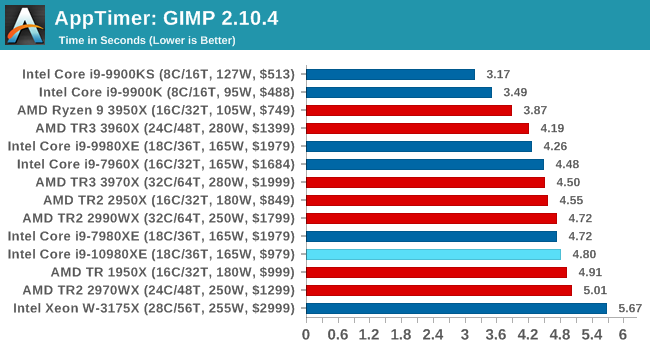
We saw a slight regression here with the 10980XE, which may be down to some of the security updates given that this benchmark tests loading a program which can involve user mode changes.
3D Particle Movement v2.1: Brownian Motion
Our 3DPM test is a custom built benchmark designed to simulate six different particle movement algorithms of points in a 3D space. The algorithms were developed as part of my PhD., and while ultimately perform best on a GPU, provide a good idea on how instruction streams are interpreted by different microarchitectures.
A key part of the algorithms is the random number generation – we use relatively fast generation which ends up implementing dependency chains in the code. The upgrade over the naïve first version of this code solved for false sharing in the caches, a major bottleneck. We are also looking at AVX2 and AVX512 versions of this benchmark for future reviews.
For this test, we run a stock particle set over the six algorithms for 20 seconds apiece, with 10 second pauses, and report the total rate of particle movement, in millions of operations (movements) per second. We have a non-AVX version and an AVX version, with the latter implementing AVX512 and AVX2 where possible.
3DPM v2.1 can be downloaded from our server: 3DPMv2.1.rar (13.0 MB)

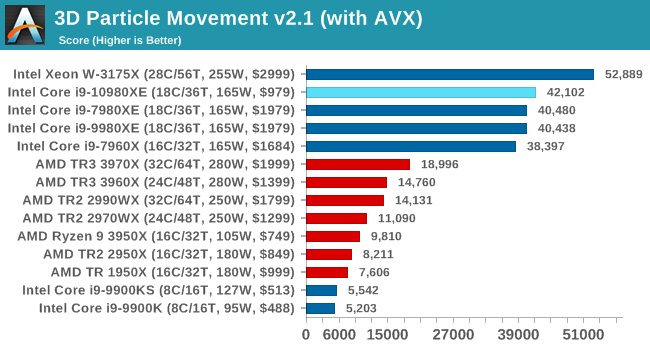
The extra frequency shows a bit here in MT mode, but otherwise equal performance to the 9980XE.
Dolphin 5.0: Console Emulation
One of the popular requested tests in our suite is to do with console emulation. Being able to pick up a game from an older system and run it as expected depends on the overhead of the emulator: it takes a significantly more powerful x86 system to be able to accurately emulate an older non-x86 console, especially if code for that console was made to abuse certain physical bugs in the hardware.
For our test, we use the popular Dolphin emulation software, and run a compute project through it to determine how close to a standard console system our processors can emulate. In this test, a Nintendo Wii would take around 1050 seconds.
The latest version of Dolphin can be downloaded from https://dolphin-emu.org/
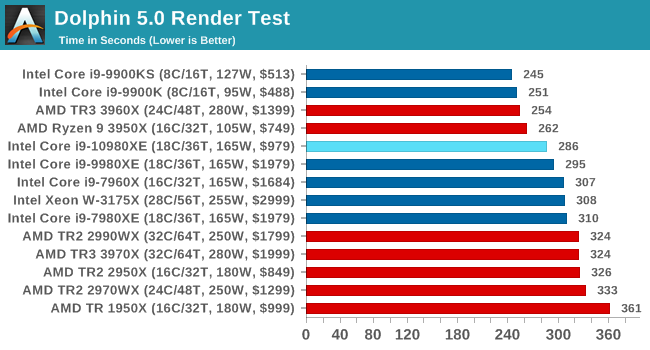
DigiCortex 1.20: Sea Slug Brain Simulation
This benchmark was originally designed for simulation and visualization of neuron and synapse activity, as is commonly found in the brain. The software comes with a variety of benchmark modes, and we take the small benchmark which runs a 32k neuron / 1.8B synapse simulation, equivalent to a Sea Slug.
Example of a 2.1B neuron simulation
We report the results as the ability to simulate the data as a fraction of real-time, so anything above a ‘one’ is suitable for real-time work. Out of the two modes, a ‘non-firing’ mode which is DRAM heavy and a ‘firing’ mode which has CPU work, we choose the latter. Despite this, the benchmark is still affected by DRAM speed a fair amount.
DigiCortex can be downloaded from http://www.digicortex.net/
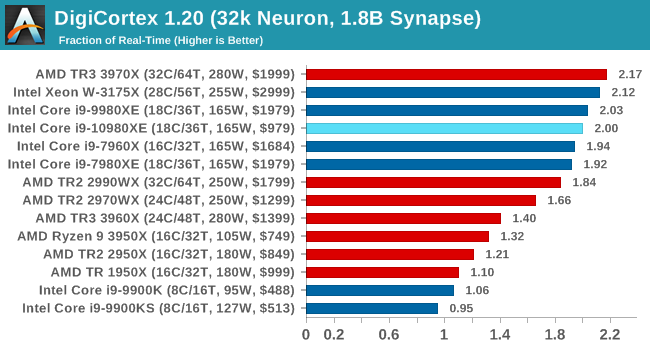
y-Cruncher v0.7.6: Microarchitecture Optimized Compute
I’ve known about y-Cruncher for a while, as a tool to help compute various mathematical constants, but it wasn’t until I began talking with its developer, Alex Yee, a researcher from NWU and now software optimization developer, that I realized that he has optimized the software like crazy to get the best performance. Naturally, any simulation that can take 20+ days can benefit from a 1% performance increase! Alex started y-cruncher as a high-school project, but it is now at a state where Alex is keeping it up to date to take advantage of the latest instruction sets before they are even made available in hardware.
For our test we run y-cruncher v0.7.6 through all the different optimized variants of the binary, single threaded and multi-threaded, including the AVX-512 optimized binaries. The test is to calculate 250m digits of Pi, and we use the single threaded and multi-threaded versions of this test.
Users can download y-cruncher from Alex’s website: http://www.numberworld.org/y-cruncher/

Agisoft Photoscan 1.3.3: 2D Image to 3D Model Conversion
One of the ISVs that we have worked with for a number of years is Agisoft, who develop software called PhotoScan that transforms a number of 2D images into a 3D model. This is an important tool in model development and archiving, and relies on a number of single threaded and multi-threaded algorithms to go from one side of the computation to the other.
In our test, we take v1.3.3 of the software with a good sized data set of 84 x 18 megapixel photos and push it through a reasonably fast variant of the algorithms, but is still more stringent than our 2017 test. We report the total time to complete the process.
Agisoft’s Photoscan website can be found here: http://www.agisoft.com/
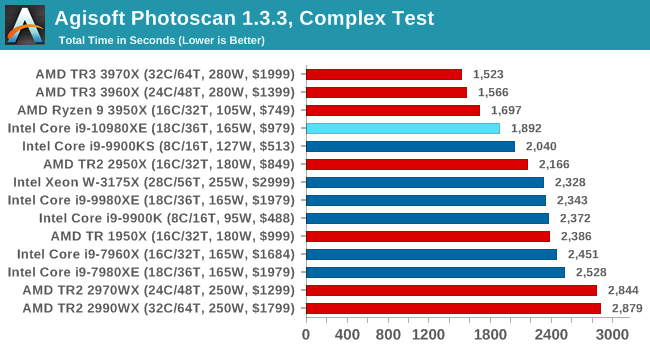
The 10980XE here becomes the fastest Intel CPU we've tested on Photoscal, with a sizeable uplift over the 9980XE. This is likely due to the faster memory.












79 Comments
View All Comments
wow&wow - Monday, November 25, 2019 - link
‘consumers don’t care about process nodes, so you shouldn’t either’The ex-CEO said, Intel processors function as intended, no bug, so using the design shortcut of partial addresses, causing many more security holes than AMD's, is intended, and enterprise and consumers don't care, so you shouldn’t either!
The more the security holes, the more the demand; what an amazing company and business!
nt300 - Tuesday, November 26, 2019 - link
Intel Processors even dating back to 2008+ all have massive amounts of security and malware vulnerabilities nightmare. Not only is ZEN superior technologically, its faster, securer and much more cost effective.HideOut - Monday, November 25, 2019 - link
You state that the AMD loses on PCI lanes but those PCI lanes are 4.0 vs 3.0. They are twice as fast per lane. With the right hardware the total bandwidth is the exact same.Thanny - Wednesday, November 27, 2019 - link
Which means nothing if you can't use your RAID controller or 10g network card because there aren't enough lanes to create the required expansion slots.I don't think there's a single X570 board capable of running a computer with a RAID controller or 10g network card, both of which require x8 slots. You could, in principle, bifurcate lanes to create more slots, but no one does that. So the fact that the lanes are PCIe 4.0 is utterly irrelevant.
If you want a non-toy computer, you need either Intel's -E/-X series processors, or, since 2017, AMD's Threadripper processors.
kc77 - Tuesday, November 26, 2019 - link
That summary makes no sense. The desktop AMD chip is beating the HEDT one with a $500 savings when you factor in motherboard cost. It's even beating it in gaming.If you picked up an older threadripper part for productivity it will walk all over the HEDT part and still be cheaper.
It doesn't matter what Intel does there's an AMD part available for cheaper.
Thanny - Wednesday, November 27, 2019 - link
TR 2000 is now cheaper, but its per-core performance lags behind Cascade Lake-X. It also has a higher-latency topology. If you want a real computer capable of running a RAID controller and 10g network card, for example, that also games reasonably well, and don't need really high core counts, then you'll get better results with Cascade Lake-X at the lower end.AMD has blundered. They should have released a 16-core Zen 2 chip, made it compatible with X399, and made it no more expensive than the MSRP of the 2950X.
kc77 - Wednesday, November 27, 2019 - link
If you're going HEDT you need the cores that's the whole point. Further more if you need ECC you won't get that with these HEDT parts while you will on all Ryzen CPUs from the bottom to the top.For HEDT ECC can be mandatory. If you want that with Intel you'll spend an extra $1000. Nope not joking.
Jimbo Jones - Friday, November 29, 2019 - link
"If you need HEDT but don't need cores ..."i7-7740x anyone? That CPU was laughed out of existence. Even the 8 core AMD TR died a quick death. That's how many people need a low core count HEDT processor.
peevee - Wednesday, November 27, 2019 - link
AMD NEEDS 20-core TR right under $1000 to fill the gap between $750 3950X and $1400 3650X and take the ground from under Intel's 18-core part. Unfortunately, they are almost out of numbers. 3955X? ;)They would benefit from a $800 16-core part too, perfect for those who are limited by PCI lanes or memory on 3950X.
Thanny - Wednesday, November 27, 2019 - link
As I see it, AMD is being daft by not releasing an X399-compatible 16-core Threadripper 3955X based on Zen 2.